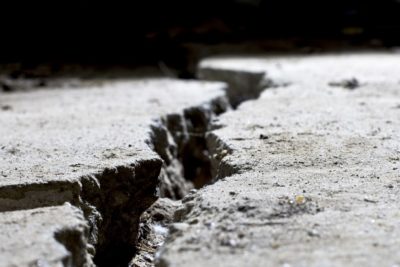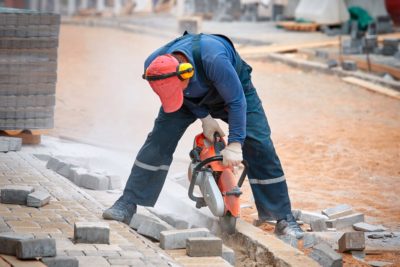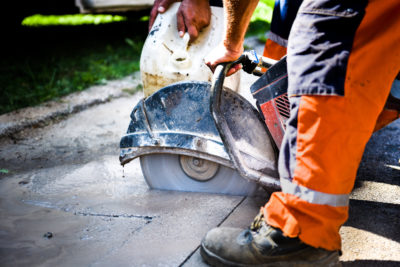Concrete cancer can be deadly to any construction project. Early detection may save you time, money, effort and your project as a whole!
What Is Concrete Cancer?
When concrete becomes subject to certain conditions, degradation occurs. We refer to this contamination-based degradation, damage, erosion and chipping as “concrete cancer”. Essentially, the concrete is eaten away over time, wreaking unseen havoc and posing severe threats to human safety.
What Type of Failure Happens in Concrete?
From flaking concrete to salt-contaminated concrete, concrete cancer runs rampant in many different ways.
Delamination
Delamination occurs when two concrete sections are placed together without bonding well, forming two or more layers usually due to a delay in the concrete pouring process. Unseen to the naked eye, delamination can be detrimental to any construction project.
Tanking
When concrete is screeded before it has had time to bleed, the water inside the concrete evaporates, producing a porous effect as the concrete is filled with tiny voids.
Honeycombing
Honeycombing in concrete appears coarse, usually present on the surface of a concrete slab. The affected area becomes weakened in durability and strength and has an improper appearance.
De-bonding
If the steel rebar in a concrete slab moves for any reason during the setting process, the bars and concrete may de-bond. If the rebar moves too much, a void may form around the rebar, causing the de-bonding.
Salt-Based Contamination
Salt-based concrete contamination occurs when concrete is exposed to chloride (salt), especially in buildings near the ocean and prone to flooding. Chloride based concrete degradation, whether frequent or occasional, causes moisture pockets to form in cracks and crevices that will carry on eating away at the concrete.
The biggest problem with salt contamination is that it eats away not only at the concrete but also at the steel rebar. The reinforcement bars expand and contract, placing stress on the surrounding concrete and speeding up the damage and degradation of the building.
Alkali-Silica Reactions
This technical term refers to the process during which specific molecules and materials in the concrete react with alkali that is found in moisture and water in its pores. The exposure creates an alkali-silica reaction. This reaction is caused by moisture, which leads to expansion, cracks, and damage to the concrete.
Concrete Spalling
With steel and iron bars or mesh, reinforced concrete can be exposed to air and water through leaks. When this exposure occurs, a weak carbonic acid starts to form, and the steel begins to corrode. Since concrete is a porous material and can easily absorb the elements around it, the concrete will inevitably absorb this corroding acid too. The steel expands once the corrosion starts, causing the surrounding concrete to crack, known as spalling.
What Causes Concrete Cancer: What Are the Possible Causes of the Concrete Failure?
While there are many possible causes of concrete cancer, here are the six most common:
- Poor waterproofing
- Salt-water chlorides for buildings near the sea
- Building defects
- Weather
- Poor quality concrete and insufficient concrete cover
- The movement of the earth under the structure leads to cracks
How Do You Identify Concrete Defects?
The easiest and most effective way to identify concrete cancer and other defects are through concrete scanning. Of the three ways to scan concrete, GPR scanning is the preferred method.
GPR Scanning
Ground Penetrating Radar (GPR) recognises the voids within a concrete slab or beam. Via GPR scanning, engineers can swiftly, safely and cost-effectively examine significant areas of concrete to identify any defects. GPR scanning usually occurs in the early stages of a construction project to avoid future problems.
How to Fix Concrete Cancer
What if the defects weren’t detected early enough? Can concrete cancer be fixed?
How do you stop concrete from deteriorating?
At the end of the day, if concrete cancer is detected, you want to stop the concrete from deteriorating any further than it already has. Here are the steps to follow:
1. Self-Diagnosis
Here are a few tell-tale signs of concrete cancer:
- Cracking or crumbling concrete
- Rust stains emerging from the concrete
- Bubbling concrete render
- Roof leaks or leaks in internal walls
- Concrete expansion
2. Get a Professional Opinion
If you’ve performed an informal inspection and you suspect your building has been affected by concrete cancer, contact a professional such as remedial builders or waterproofing contractors to determine what type of repair work has to be done. The earlier you catch concrete cancer and have it fixed, the better!
3. Correct the Problem
Different solutions may apply depending on the cause of concrete cancer.
3.1. Polymer-Modified Repair System Solution
This way, you can remove the concrete around the reinforcing bars and cleans the steel before applying both the steel primer and a polymer-modified material.
3.2. Electrochemical Treatment Option
If there’s chloride contamination in a structure near the ocean, you might need to have specialist repair work done to treat concrete cancer. This can include an electrochemical treatment, such as cathodic protection.
Cathodic protection is one of the best methods for preventing corrosion on a metal surface. This technique is based on converting active areas on a metal surface to passive or making them the cathode of an electrochemical cell.
3.3. Simple Replacement Method
Less severe damage might enable repairing concrete by removing the damaged concrete, cleaning and replacing the rusted, exposed steel, and then filling in the cracks.
4. Act Preventatively
When it comes to concrete cancer, prevention is vital. That’s where GPR scanning comes into play. If, however, concrete cancer repair is necessary, you’ll want to ensure that it doesn’t happen again.
Waterproofing concrete is vital to prevent water from corroding the steel beams. Consider high-quality waterproofing options to seal the new concrete horizontal surfaces. This minimises the risk of future water damage and further prevents harsh chemicals from contaminating the concrete by entering through pores.
The Best Way to Combat Concrete Cancer
We’ve said it once, and we’ll repeat it: The best way to combat concrete cancer is to use Ground Penetrating Radar to scan your concrete surface for defects before starting a construction project. Early detection will save your project time and resources, and it may even save lives!
GPR Scanning Experts
Diamond Cut Concrete has been in the concrete business for years, making us experts at all things concrete-related. Contact us today for all your concrete questions answered, from diamond wire cutting to GPR scanning!



